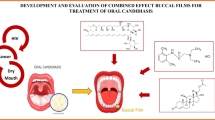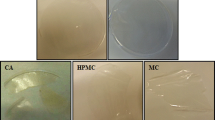Abstract
Our objective was to evaluate the application of polyoxyethylene homopolymers in buccal bioadhesive drug (BBD) delivery device formulations. The bioadhesive strength of four different molecular weight (MW) polyoxyethylene polymers was measured by Instronâ tensile tester using glass plate and bovine sublingual tissue as substrate surfaces. Several BBD device formulations containing polyoxyethylene polymer (MW 7,000,000) were prepared by direct compression and compression molding processes. The prepared BBD devices were evaluated for their elasticity, in vitro adhesion and drug release characteristics. The in vivo bioadhesion characteristics of a placebo compression molded device were examined in 3 adult healthy male beagle dogs. The bioadhesive strength of polyoxyethylene polymers appeared to be directly related to their molecular weights. When bovine sublingual mucosa or a glass plate was used as model mucosal substrate surface, the rank order of bioadhesive strength of different molecular weight polyoxyethylene polymers was similar. The bioadhesive strength of devices prepared by the compression molding process was greater than those prepared by direct compression, but the kinetics of drug release were independent of the process used for the preparation of the devices. The drug release and the bioadhesive strength of the similarly prepared device formulations appeared to be dependent on the drug:polymer ratios. The elasticity of the BBD devices prepared by compression molding was improved by the inclusion of polyisobutylene polymer in the formulations. When adhered to the oral cavity of the dogs, the compression molded placebo BBD device exhibited adhesion for at least 4 hours and appeared to show no signs of local irritation. In conclusion, BBD devices containing polyoxyethylene polymer (MW 7,000,000) can be prepared by direct compression or compression molding process in order to provide controlled drug release to the oral cavity while maintaining appropriate bioadhesive characteristics.
Similar content being viewed by others
References
Veillard MM, Longer MA, Martens TW, Robinson JR. Preliminary studies of oral mucosal delivery of peptide drugs. J Controlled Release. 1987;6:123–131.
Ponchel G. Formulation of oral mucosal drug delivery systems for the systemic delivery of bioactive materials. Adv Drug Delivery Rev. 1994;13:75–87.
Jimenez-Castellanos MR, Zia H, Rhodes CT. Mucoadhesive drug delivery systems. Drug Dev Ind Pharm. 1993;19:143–194.
Duchene D, Touchard F, Peppas NA. Pharmaceutical and medical aspects of bioadhesive systems for drug administration. Drug Dev Ind Pharm. 1988;14:283–318.
Park K, Robinson JR. Bioadhesive polymers as platforms for oral-controlled drug delivery: method to study bioadhesion. Int J Pharmacol. 1984;19:107–127.
Helliwell M. The use of bioadhesives in targeted delivery within the gastrointestinal tract. Adv Drug Delivery Rev. 1993;11:221–251.
Gupta A, Garg S, Khar RK. Interpolymer complexation and its effect on bioadhesive strength and dissolution characteristics of buccal delivery systems. Drug Dev Ind Pharm. 1994;20:315–325.
Satoh K, Takayama K, Machida Y, Suzuki Y, Nakagaki M, Nagai T. Factors affecting the bioadhesive property of tablet consisting of hydroxy propyl cellulose and carboxyvinyl polymer. Chem Pharm Bull. 1989;37:1366–1368.
Chen JL, Cyr GN. Compositions producing adhesion through hydration (Chapter 10). In: Manly RS, ed. Adhesive Biological Systems. New York, NY: Academic Press; 1970:163–181.
Merkle HP, Wolany G. Buccal delivery of peptide drugs. J Controlled Release. 1992;21:155–164.
Mortazavi SA, Smart JD. An in vitro method for assessing the duration of mucoadhesion. J Controlled Release. 1994;31:201–212.
Smart JD. An in vitro assessment of some mucosa-adhesive dosage forms. Int J Pharmacol. 1991;73:69–74.
Smart JD. Drug delivery using buccal-adhesive systems. Adv Drug Delivery Rev. 1993;11:253–270.
Bottenberg P, Cleymae R, Muynck C, Remon JP, Coomans D, Michotte Y, Slop D. Development and testing of bioadhesive fluoride-containing slow-release tablets for oral use. J Pharm Pharmacol. 1991;43:457–464.
Bottenberg P, Cleymae R, Muynck C, Remon JP, Coomans D, Slop D. Comparison of salivary fluoride concentrations after administration of a bioadhesive slow-release tablet and a conventional fluoride tablet. J Pharm Pharmacol. 1992;44:684–686.
SentryÒ PolyoxÒ WSR, NF- Polyethylene oxide [product literature]. Danbury, Conn: Union Carbide; 1995.
Eckhart CG, McCorkle T. Chlorpheniramine maleate. In: Florey K, ed. Analytical Profiles of Drug Substances-Volume 7. New York, NY: Academic Press; 1978:45–80.
Schott H. Polymer Science. In: Martin A, Bustamante P, Chun AHC, eds. Physical Pharmacy. Malvern, PA: Lea & Febiger, 1993:578–579.
Cherukuri SR, Friello DR, Ferroti M, Jewell W, D'Amelia RP, inventors; Nabisco Brands Inc. New York, NY Gum base, chewing gum containing same and method. US patent 4,352,822. Oct. 5, 1982.
Mackay DAM, Warren K, Witzel F, Schoenholz D, inventors; Life Savers Inc. New York, NY. Long-lasting flavored chewing gum including chalk-free gum base. US patent 4,062,274. Dec. 20, 1977.
Song JH, Greenberg MJ, Record DW, Zibell SE, Broderick K, Schnell PG, inventors; Wrigley, Jr. Co. Chicago, IL. Gum composition containing dispersed porous beads containing active chewing gum ingredients and methods. US patent 5,154,927. Oct. 13, 1992.
Broderick KB, Record DW, inventors; Wrigley, Jr. Co. Chicago, IL. Gum composition containing dispersed porous beads containing active chewing gum ingredients and method. US patent 5,139,787. Aug. 18, 1992.
K. Satoh, K. Takayama, Y. Machida, Y. Suzuki, M. Nakagaki and T. Nagai. Factors affecting the bioadhesive property of tablet consisting of hydroxy propyl cellulose and carboxyvinyl polymer. Chem. Pharm. Bull. 1989;37:1366–1368.
M. Pederson and M.R. Rassing. Miconazole chewing gum as a drug delivery system test of release promoting additives. Drug Dev. Ind. Pharm. 1991;17:411–420.
T. Anderson, M. Gram-Hansen, M. Pedersen and M.R. Rassing. Chewing gum as a delivery system for nystatin influence of solubilizing agents upon the release of water insoluble drugs. Drug Dev. Ind. Pharm. 1990;16:1985–1994.
Author information
Authors and Affiliations
Corresponding author
Additional information
Published: September 15, 1999.
Rights and permissions
About this article
Cite this article
Tiwari, D., Sause, R., Madan, P.L. et al. Evaluation of polyoxyethylene homopolymers for buccal bioadhesive drug delivery device formulations. AAPS PharmSci 1, 13 (1999). https://doi.org/10.1208/ps010313
Received:
Accepted:
Published:
DOI: https://doi.org/10.1208/ps010313




